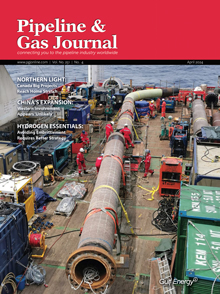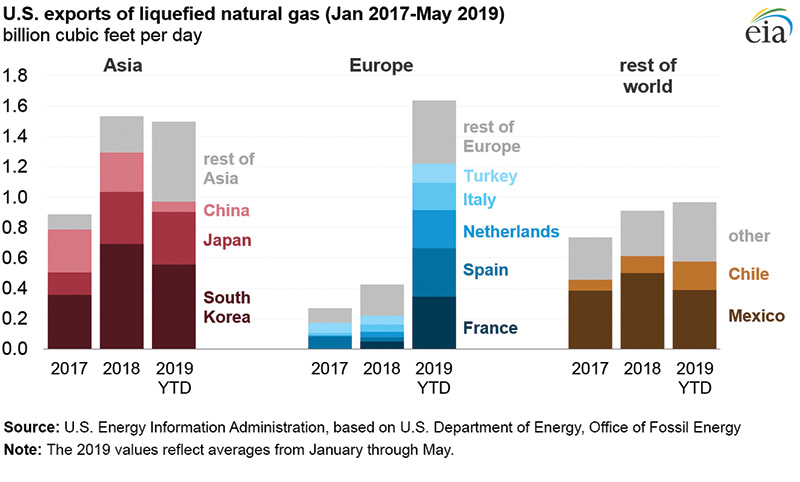September 2019, Vol. 246, No. 9
Global News
U.S. LNG exports to Europe Grow as Asian Demand Dips
U.S. LNG exports have been growing steadily and reached a new peak of 4.7 Bcf/d in May 2019, according to the latest data published by the U.S. Department of Energy’s Office of Fossil Energy.
This year, the United States became the world’s third-largest LNG exporter, averaging 4.2 Bcf/d in the first five months of the year, exceeding Malaysia’s LNG exports of 3.6 Bcf/d during the same period. The United States is expected to remain the third-largest LNG exporter in the world, behind Australia and Qatar, in 2019-20.
U.S. LNG exports have increased as four new liquefaction units with a combined capacity of 2.4 Bcf/d came online since November 2018. Although Asian countries have continued to account for a large share of U.S. LNG exports, Europe’s share has increased significantly since October 2018 and accounted for almost 40% of U.S. LNG exports in the first five months of 2019. LNG exports to Europe surpassed exports to Asia for the first time in January 2019.
A warm winter in Asia and declining price differentials between European and Asian spot natural gas prices led to increased volumes of U.S. LNG exports delivered to Europe. Europe’s total LNG imports in the winter of 2018–19 averaged 10.2 Bcf/d – 60% higher than in the previous two winters and the highest winter average since at least 2013, according to CEDIGAZ LNG data.
LNG imports to Europe have been relatively low in recent years, but they are expected to grow as new LNG supply comes online and European countries continue to increase natural gas consumption as part of their decarbonization initiatives.
Total LNG imports in the three largest global LNG markets – Japan, China, and South Korea – started to decrease in February 2019 amid a milder-than-normal winter and, in Japan, the restart of nuclear power plants. China, which has surpassed South Korea to become the world’s second-largest LNG importer and now leads Japan and Germany as the largest importer of total natural gas, continued to increase LNG imports. Its LNG imports were up by 20% (1.3 Bcf/d) in the first five months of 2019 compared with the same period last year, as the country continued to expand LNG import capacity and implement coal-to-gas switching policies.
LNG from the United States accounted for 7% of China’s total LNG imports in the first six months of 2018. In September 2018, China imposed a 10% tariff on LNG imports from the United States, and in the months since then (October 2018 through May 2019), U.S. LNG has accounted for 1% of China’s LNG imports. P&GJ






Comments